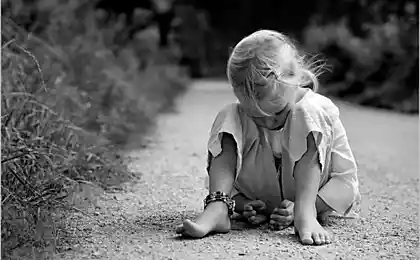437
To hide the injury
The loss of a loved one, illness, dismissal from work and other troubles always leave us a trail. Should come to any psychological training, you immediately make sure that even the most prosperous-looking man there is the history of received emotional, mental and physical injuries. In his grief we are not the original...and, frankly, not interesting, at least for a long time.
But many continue year after year to carry their "corn" and become more and more attached to her. Why not work? A child injured arm. Why not go to travel? Once almost crashed our plane! Why no family? Because seven years ago broke the old, beloved...

Psychologists have identified several stages of grief (mind you, we are talking about serious tragic event, for example, the loss of a loved one). The first is shock and numbness, when the person is not able to acknowledge what happened, a kind of "emotional numbness"; the duration of this stage from several seconds to several weeks in the most difficult cases, on the average 7 days. The second stage is the phase of acute grief characterized by strong emotions, leaving from the outside world, loss of power and sometimes physical ailments. Duration – from 3 days to 6-7 weeks.
The third stage of obsession, the hardest, because in this period come the heavy thoughts, everything reminds about the tragedy, but life does not stand still and requires reorganization, it delivers another portion of the pain... it also Lasts 6-7 weeks. Then there is the working out of the problem – the last phase, which lasts up to a year. Here to pronounce the last "I'm sorry and goodbye", the pain recedes, and life enters a new track. The first anniversary of the tragedy is the last day of this stage. In norm it is the completion of the traumatic situation. The maximum residence time of deep grief, therefore, is about a year and three months.
If the person gets stuck in the last phase, his grief becomes chronic. Of course, over the years, it loses sharpness, psychologists call this state of "neurotic experience" – it actually occurred it is almost not the case. From the description of the stages of grief becomes clear that most of the time we generously retell a traumatic story to everyone around, she already lived and experienced fully. It is not more than a cast of real-life events, and the impression much corrected us.
To hide the trauma is useful. Each time returning to a painful history, we are trying to "revive", to give the experience of visual to to defend their right to inaction, right to the suffering, in fact the same – to justify them. But every story of our feelings in this story is less (in contrast to traumatic stories that we bear in silence, – they can greatly affect the life, but just to remain lost, buried inside). We just refuse to live, clinging to scary stories from the past. We are afraid of life. Each person will find many excuses, many tearful and bloody stories that explain its deadness. Yeah, that's what the word DEADNESS.
First, we create our own prison of his traumatic experience, and then start the prison to hide to avoid the experience of a lifetime. Hiding in your injury, the most we get is security (unless you are not afraid of the prospect to spend the rest of my life dead), self-pity and for some time the sympathy of others. You can remain in righteousness ("You have no idea what I went through!"), but the price of this innocence – bright, happy, eventful life.
Living in their grief and coming back after him for active life, we take the risk. Yes, it is possible again to lose a loved one, not to carry a child to be dismissed from work, get into a dangerous situation... Life doesn't give guarantees – only opportunities. The ability to create warm and sincere relations with people, to work, to bring something of their own, individual in this world, to learn new things, to travel...
But for you it's worth to risk it again?
P. S. And remember, just changing your mind — together we change the world! ©
Source: /users/9001
But many continue year after year to carry their "corn" and become more and more attached to her. Why not work? A child injured arm. Why not go to travel? Once almost crashed our plane! Why no family? Because seven years ago broke the old, beloved...

Psychologists have identified several stages of grief (mind you, we are talking about serious tragic event, for example, the loss of a loved one). The first is shock and numbness, when the person is not able to acknowledge what happened, a kind of "emotional numbness"; the duration of this stage from several seconds to several weeks in the most difficult cases, on the average 7 days. The second stage is the phase of acute grief characterized by strong emotions, leaving from the outside world, loss of power and sometimes physical ailments. Duration – from 3 days to 6-7 weeks.
The third stage of obsession, the hardest, because in this period come the heavy thoughts, everything reminds about the tragedy, but life does not stand still and requires reorganization, it delivers another portion of the pain... it also Lasts 6-7 weeks. Then there is the working out of the problem – the last phase, which lasts up to a year. Here to pronounce the last "I'm sorry and goodbye", the pain recedes, and life enters a new track. The first anniversary of the tragedy is the last day of this stage. In norm it is the completion of the traumatic situation. The maximum residence time of deep grief, therefore, is about a year and three months.
If the person gets stuck in the last phase, his grief becomes chronic. Of course, over the years, it loses sharpness, psychologists call this state of "neurotic experience" – it actually occurred it is almost not the case. From the description of the stages of grief becomes clear that most of the time we generously retell a traumatic story to everyone around, she already lived and experienced fully. It is not more than a cast of real-life events, and the impression much corrected us.
To hide the trauma is useful. Each time returning to a painful history, we are trying to "revive", to give the experience of visual to to defend their right to inaction, right to the suffering, in fact the same – to justify them. But every story of our feelings in this story is less (in contrast to traumatic stories that we bear in silence, – they can greatly affect the life, but just to remain lost, buried inside). We just refuse to live, clinging to scary stories from the past. We are afraid of life. Each person will find many excuses, many tearful and bloody stories that explain its deadness. Yeah, that's what the word DEADNESS.
First, we create our own prison of his traumatic experience, and then start the prison to hide to avoid the experience of a lifetime. Hiding in your injury, the most we get is security (unless you are not afraid of the prospect to spend the rest of my life dead), self-pity and for some time the sympathy of others. You can remain in righteousness ("You have no idea what I went through!"), but the price of this innocence – bright, happy, eventful life.
Living in their grief and coming back after him for active life, we take the risk. Yes, it is possible again to lose a loved one, not to carry a child to be dismissed from work, get into a dangerous situation... Life doesn't give guarantees – only opportunities. The ability to create warm and sincere relations with people, to work, to bring something of their own, individual in this world, to learn new things, to travel...
But for you it's worth to risk it again?
P. S. And remember, just changing your mind — together we change the world! ©
Source: /users/9001
Conchita tolerance. The struggle for the right to lose the human form
All for Feng-Shui: Chinese garden for Your home























